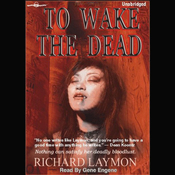 First off, there's something bothering me that I have to get out of the way right off the bat. Amara, the main subject of To Wake the Dead, looks nothing at all like the figure on the cover. Laymon's Amara is a 4,000-year-old Egyptian mummy, and she looks just like one, with beef-jerky skin, shriveled breasts (a fact that every character seems to notice), and no eyes in her empty sockets. So if you're looking for a story that features the vital (Asian?) vampiress depicted on the cover illustration, I'm afraid you're going to have to keep looking.
First off, there's something bothering me that I have to get out of the way right off the bat. Amara, the main subject of To Wake the Dead, looks nothing at all like the figure on the cover. Laymon's Amara is a 4,000-year-old Egyptian mummy, and she looks just like one, with beef-jerky skin, shriveled breasts (a fact that every character seems to notice), and no eyes in her empty sockets. So if you're looking for a story that features the vital (Asian?) vampiress depicted on the cover illustration, I'm afraid you're going to have to keep looking.Now that subject has been covered, let's move on....
After the death of horror author Richard Laymon in 2001, his international fan base mourned the loss of a writer who seemed to still be improving his craft. (He won his first Bram Stoker Award posthumously for The Traveling Vampire Show, widely considered his best work.) Then three complete, previously unpublished manuscripts were found among his files. One of these was published each year from 2003 to 2005. They were, in order, To Wake the Dead (UK title: Amara), The Lake (same in the UK), and Into the Fire (UK title: The Glory Bus).
To Wake the Dead is the most ambitious novel by Laymon I've read to date. In the other novels of his I've encountered, the author has tended to focus on a relatively small cast of characters that we get to really know before he kills most of them.
In To Wake the Dead, however, there are several stories running parallel to each other, each with its own cast of characters, giving the novel a similar feel to a Robert Altman film. The focus is on Amara, an Egyptian mummy brought to a Los Angeles museum, but along the way, we meet a vast array of other individuals, each with their own struggles:
Virgina, Ed, and Marco, a trio of caged captives, are held as sex slaves by a mysterious kidnapper who only moves around in the dark. April, a young blind woman, alone in her remote mansion, receives an unexpected, but not unwelcome, visitor. Susan, the woman in charge of the mummy exhibit, has to deal with unexplained murders surrounding her new acquisition. Her cop boyfriend, Tag, has his own problem in the form of Mabel, a hygienically challenged woman who wants Tag to be her lover. Teenaged Grace, along with her boyfriend and sister, makes her way to Hollywood to be a star. And Imad, a local womanizer, proves to be the source of some surprising information.
Laymon somehow manages to make all these varied plotlines skillfully come together at just the right moments. He doesn't make the obvious choices, and manages to breathe some new life into an idea whose time came and went long ago (and that includes the laughable series of recent "mummy" movies). To Wake the Dead has the same flaws of most of Richard Laymon's bibliography, namely an overabundance of breast references, a reliance on implausible plot contrivances based on the characters' stupid decisions, and villains that are really more disgusting than they need to be. But, at the same time, it also has that wonderful Laymon charm that keeps you going in spite of these drawbacks.
Reader Gene Engene (who has a vocal range very similar to his colleague Michael Taylor) has a facility with accents that more than makes up for his limited number of female voices; his males fare considerably better, and it seems the more despicable the character, the more fun he has with stretching his talent. But, other than the characters not sounding the same as they do in your head, there is just one main difference between reading and listening: the speed. Visual reading speed is variable, but with a CD, you can't listen any faster or slower than the pace of Engene's voice, which leaves space for dramatic pauses and the like.
In the case of this book, that means the squeamish will be unable to skim the nastier elements of Laymon's story (and they're not always where or when you think they'll be), and you can't peek ahead to see what's about to happen — which results in at least one oh my god!–level surprise. The only drawback is that it makes To Wake the Dead seem just a bit longer than it would otherwise. Sometimes, when you just want the story to get going so you can find out what's going to happen next, that is frustrating. But more often, Engene's pacing leaves room for an appreciation for Laymon's inimitable way with words.




























2 comments:
Richard Laymon is one of my favourite horror writers. I've read 'Amara'. It is a book with its own atmosphere and I do wonder how that can be translated by a single person on to an audio disc.
Vincent Price - yes, he could do it.
Another thing that would put me off is Gene Engene - surely, not his real name? - because that name sounds like something to do with genetic engineering.
I noticed that similarity of name, too, but "Engene" is pronounced "En-ga-nee," which makes it a little easier to take.
But one does wonder at the parents who would make that choice, especially if Gene is short for Eugene.
Eugene Engene? That constitutes child abuse in my book. :)
Post a Comment